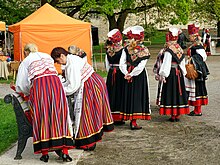
Back Култура на Естония Bulgarian Cultura de Estonia Spanish Eesti kultuur Estonian Viron kulttuuri Finnish Culture de l'Estonie French Estisk kultur NN Cultura da Estônia Portuguese Культура Эстонии Russian Kultura e Estonisë Albanian Estonya kültürü Turkish


| Part of a series on the |
| Culture of Estonia |
|---|
 |
| People |
| Languages |
| Cuisine |
| Festivals |
| Religion |
| Sport |
The culture of Estonia combines an indigenous heritage, represented by the country's Finnic national language Estonian, with Nordic and German cultural aspects. The culture of Estonia is considered to be significantly influenced by that of the Germanic-speaking world.[1] Due to its history and geography, Estonia's culture has also been influenced by the traditions of other Finnic peoples in the adjacent areas, also the Baltic Germans, Balts, and Slavs, as well as by cultural developments in the former dominant powers, Sweden, Denmark and Russia. Traditionally, Estonia has been seen as an area of rivalry between western and eastern Europe on many levels. An example of this geopolitical legacy is an exceptional combination of multiple nationally recognized Christian traditions: Western Christianity (the Catholic Church and the Estonian Evangelical Lutheran Church) and Eastern Christianity (the Orthodox Church (the Estonian Apostolic Orthodox Church)). The symbolism of the border or meeting of east and west in Estonia was well illustrated on the reverse side of the 5 krooni note. Like the mainstream cultures in the other Nordic countries, Estonian culture can be seen to build upon ascetic environmental realities and traditional livelihoods, a heritage of comparatively widespread egalitarianism arising out of practical reasons (freedom to roam and universal suffrage), and the ideals of closeness to nature and self-sufficiency.